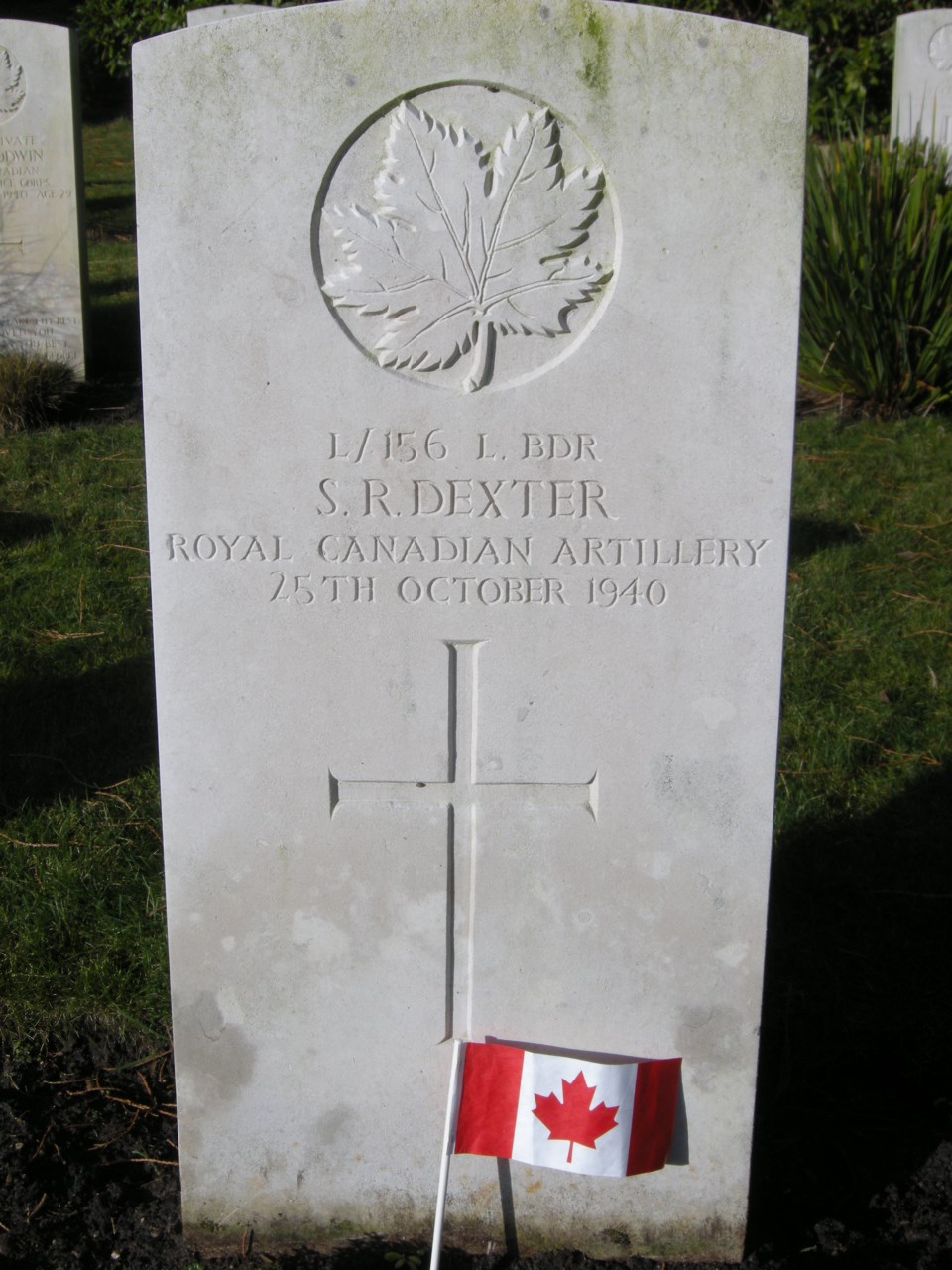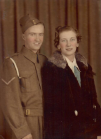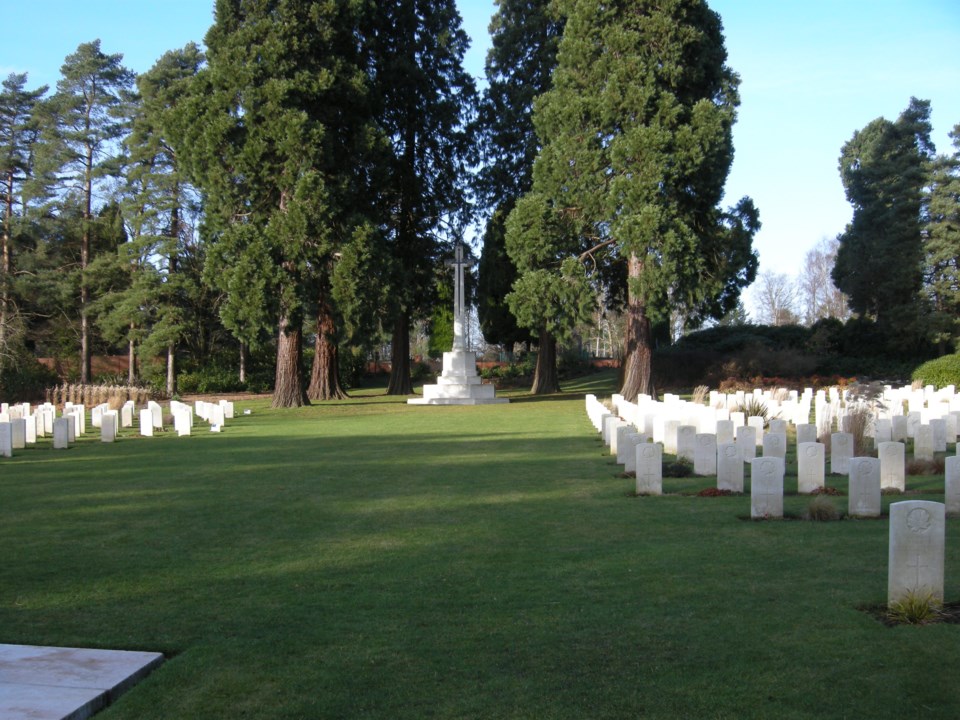Editor’s Note:
Below is a submitted article from Ray Richards, regarding Lance Bombardier Dexter who lived in Moose Jaw.
Richard says, “I was born in Moose Jaw on Oct. 9, 1929. My paternal grandparents lived at 1067 Fourth Ave. N. E. but I don’t remember the address of my maternal grandparents. I did not live in Moose Jaw but in a small hamlet, Bateman, where my parents had a country store. I remember quite a lot of the 1930s and 1940s. I have read some of the articles about various veterans that have appeared in Moose Jaw Today and thought that you might be interested in Stan’s history. He was sent overseas in 1939 and was killed by a mine on the south coast of England, October 1940.”
Lance Bombardier DEXTER, STANLEY REGINALD
Information gathered by Raymond Bertram Richards.
Stan was a younger brother of my Mother, Clara Dexter, thus was my Uncle.
Date of birth: 6th December 1911 England, Essex County, Barking
Father: William Daniel Dexter; Mother: Harriett Dexter Sisters: Violet May 30, Clara 34.
Family moved to Moose Jaw, Saskatchewan, Canada.
September 1928, Stan joined the King’s Own Rifles of Canada, a militia unit then the 77th Field Battery, R.C.A. served until April 1, 1935 when he left for Toronto.
In 1935, Saskatchewan was in the midst of a drought and an economic depression that started in 1929 and ended in 1939 and there was massive unemployment.
When war was declared, he went to Moose Jaw and enlisted in the 77th Field Battery
6th October 1939, attested and appointed Lance Bombardier
7th October 1939, detailed to attend C S T C Kingston, Ontario.
7th December 1939, rejoined unit en route overseas at Smith Falls, Ontario
20 December 1939, Aldershot, England -Taken On Strength 3rd Cdn Field Reg’t E Battery RCA
28 October 1940, 1310 hours Died Accident stepped on a mine, Shoreham Beach, Shoreham-by-Sea while laying a communication line.
(Details in a Court of Inquiry below. A local Constable John Henry Sopp was called to investigate).
Residence on Enlistment: 37 Beverly Street, Toronto (4 blocks west of University Ave. and one block north of Queen St.).
Wife Sylvia Carol Dexter, married Aug 6, 1938, no info on her maiden name See photo.
Residence date of death: 153 Beverly Street, Toronto. There is then 64 Triller Ave., Toronto and the Court of Inquiry report sent to Sylvia at 161 College St. Toronto and to his parents at 152 Hochelaga W., Moose Jaw and to my Mother, his sister Clara, at Bateman, Sask. Notification of medals sent to 975 Cadillac St. Windsor, Ont then changed on 22 March 1951 to 3251 Columbus Ave., Detroit 6, Michigan, U.S.A.
Death Report also shows: Uncle Mr. Bentley lives at The Anchor, Liverpool Rd., Canning Town, London E16 England.
Buried at Brookwood Cemetery, Surrey, England Plot No.111A, Row P, Grave 2 , 29 October 1940.

War Service Gratuity $207.36: Calculated as 386 days service /30 = 12 completed months at $7.50 = $90.00; Overseas service 322 days -26 ineligible = 206 days at $0.25 = $74.00; Supplement pay, allowance and dependent allowance $3.52 per day x 7 days =$24.64 x322/183 = $43.36 = Total $207.36 sent to his wife, Sylvia, at 64 Triller Ave.
Awards: Defence Medal; War Medal; Canadian Voluntary Service Medal & Clasp
COURT OF INQUIRY
By Order of Lt. Col. R.A.Wyman, Cmdg. 3 Canadian Field Regiment. CASF.,To Inquire into and report on the death of L156 L/Bdr. Dexter, S.R., of the 19/77 Field Battery, 3 Cdn. Fd.Regt, through contact with a land mine at 1310 hours 25 Oct.40.
At 1350 hours on 25 Oct 1940 Gnr. Wilford phoned me from “POST” O.P.( Observation Post ) and stated that L/Bdr. Dexter, while laying a DV telephone cable from POST O.P. to the billet occupied by the O.P. party had been blown up and killed by a land mine. Gnr. Wilford stated that he was about 10 feet from L/Bdr. Dexter when the accident occurred.
Major L.M.Jones, O.C. interviewed L/Sgt. Ingleby T.R. signals NCO, who had given L/Bdr. Dexter permission to lay the cable, and told Dexter to reconnoitre a route. Major Jones visited the scene. There were many warning signs along the beach and also along the beach road. Those might be misleading to a person who wouldn’t know exactly where the mine fields were, because in some instances billets are on the seaward side of notices which read “Beware of Mines”. The billet occupied by the O.P. party is the house called “Selmer” and is wired in with barbed wire. The billeting house is about 500 yards from the O.P. The L/Sgt. Testified he had no previous instructions regarding the mined area and had visited the POST O.P. twice. He did not have the feeling that the whole area was dangerous and gathered that the paths that led to the sea were mined. Why was Dexter laying a wire? Some of the personnel were at the billet and some were at the O.P. all the time and they wanted communication between the specialists and signallers from the billets to the O.P. because it was too far to run every time they wanted to get in touch between the two.
R5117 Gnr. Wilford R. Signals Section testified: At approx. 1255 hours L/Bdr Dexter stated he was going to lay the line from our billets on the beach to the Post O.P. about a half mile further up the beach. He started off with the reel in his hand. Five minutes later I followed and caught up to him, and I buried wire in front of a machine gun post, then I caught up to him again and walked along side of him. As we came to a concrete terrace he walked on the gravel and I on the terrace. At the far end of the terrace was an obstruction, so I walked towards the tank blocks. At that moment the explosion occurred and two more followed as I crawled behind the concrete block.
He had no idea of the actual location of the mines As far as we were concerned they were straight under the wire that followed the waterfront and this mine was about 30 feet behind it and they walked behind the wire. Was the area safe? “Well, judging from the signs all over the place, the coiled wire going through the yards – Imperial soldiers were walking all over the place, between the wire. One was standing near where it happened and didn’t say anything when we passed him. After the explosion one Imperial soldier said “I was just talking to him. I didn’t think that would happen.” So in my opinion we were following a safe route. Also inside the barbed wire section in which the mine was, was a canoe which, as far as I could see, had recently been used. As a member of the O.P.Party, he had never received any instructions as to the exact location of the mines except that the site was mined.
The opinion of this Court is that L156 L/Bdr. Dexter S.R. was killed by a land mine exploding; that no negligence was shown on the part of L/Bdr. Dexter, and the fact that the exact location of the mines in this area are not known by the personnel in this area contributed largely to the death of L/Bdr. Dexter.





